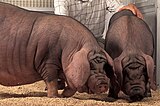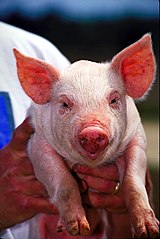Breed: Difference between revisions
m v2.04b - Bot T5 CW#16 - Fix errors for CW project (Unicode control characters) |
Jiaminglimjm (talk | contribs) →top: removed redundant overemphasis of math/set theory jargon that has little place in the complexities of biology Tags: Mobile edit Mobile app edit Android app edit |
||
| Line 3: | Line 3: | ||
{{more citations needed|date=October 2014}} |
{{more citations needed|date=October 2014}} |
||
[[File:Braunvieh am Simplonpass, Schweiz.jpg|thumb|[[Braunvieh]], a dairy breed<ref>The Cattle Site: [https://www.thecattlesite.com/breeds/dairy/31/brown-swiss/ Breeds Brown Swiss] Retrieved 22 February 2021</ref> with high milk production and little [[milk fat]]]] |
[[File:Braunvieh am Simplonpass, Schweiz.jpg|thumb|[[Braunvieh]], a dairy breed<ref>The Cattle Site: [https://www.thecattlesite.com/breeds/dairy/31/brown-swiss/ Breeds Brown Swiss] Retrieved 22 February 2021</ref> with high milk production and little [[milk fat]]]] |
||
A '''breed''' is a specific group of domestic animals having [[homogeneous]] appearance ([[phenotype]]), homogeneous [[behavior]], and/or other characteristics that distinguish it from other organisms of the same [[species]]. In literature, there exist several slightly deviating definitions.<ref>{{citation|surname1=S. J. G. Hall, D. G. Bradley |periodical=TREE|title=Conserving livestock breed biodiversity|volume=10|date=1995|issue=7|pages=267–70|doi=10.1016/0169-5347(95)90005-5|pmid=21237034}}</ref><ref name="MathBreed">{{citation|surname1=G. Langer |periodical=Archives Animal Breeding|title=Possible mathematical definitions of the biological term "breed"|volume=61|pages=229–243|date=2018|issue=2|doi=10.5194/aab-61-229-2018|doi-access=free}}</ref> Breeds are formed through [[genetic isolation]] and either natural [[adaptation]] to the environment or [[selective breeding]], or a combination of the two. Despite the centrality of the idea of "breeds" to animal husbandry and agriculture, no single, scientifically accepted definition of the term exists.{{r|fao|p=340}} |
A '''breed''' is a specific group of domestic animals having [[homogeneous]] appearance ([[phenotype]]), homogeneous [[behavior]], and/or other characteristics that distinguish it from other organisms of the same [[species]]. In literature, there exist several slightly deviating definitions.<ref>{{citation|surname1=S. J. G. Hall, D. G. Bradley |periodical=TREE|title=Conserving livestock breed biodiversity|volume=10|date=1995|issue=7|pages=267–70|doi=10.1016/0169-5347(95)90005-5|pmid=21237034}}</ref><ref name="MathBreed">{{citation|surname1=G. Langer |periodical=Archives Animal Breeding|title=Possible mathematical definitions of the biological term "breed"|volume=61|pages=229–243|date=2018|issue=2|doi=10.5194/aab-61-229-2018|doi-access=free}}</ref> Breeds are formed through [[genetic isolation]] and either natural [[adaptation]] to the environment or [[selective breeding]], or a combination of the two. Despite the centrality of the idea of "breeds" to animal husbandry and agriculture, no single, scientifically accepted definition of the term exists.{{r|fao|p=340}} A breed is therefore not an objective or biologically verifiable classification but is instead a [[term of art]] amongst groups of breeders who share a consensus around what qualities make some members of a given species members of a nameable subset.{{r|lush}} |
||
Another point of view is that a breed is consistent enough in type to be logically grouped together and when mated within the group produce the same type.<ref>Clutton-Brock, Juliet. 1987 ''A Natural History of Domesticated Mammals'', Cambridge University Press and the Museum of Natural History, page 40.</ref> When bred together, individuals of the same breed pass on these predictable traits to their offspring, and this ability{{snd}}known as "[[breeding true]]"{{snd}}is a requirement for a breed. [[Plant]] breeds are more commonly known as [[cultivar]]s. The offspring produced as a result of breeding animals of one breed with other animals of another breed are known as [[crossbreed]]s or mixed breeds. Crosses between animal or plant variants above the level of breed/cultivar (i.e. between species, [[subspecies]], [[Variety (botany)|botanical ''variety'']], even different [[Genus|genera]]) are referred to as ''[[Hybrid (biology)|hybrids]]''.<ref>Banga, Surinder S. (November 25, 1998). ''Hybrid Cultivar Development'', p. 119. Springer-Verlag. {{ISBN|3-540-63523-8}} <!--This is cited only for the fact that plant crosses above the cultivar level are called hybrids; doesn't address animals.--></ref> |
Another point of view is that a breed is consistent enough in type to be logically grouped together and when mated within the group produce the same type.<ref>Clutton-Brock, Juliet. 1987 ''A Natural History of Domesticated Mammals'', Cambridge University Press and the Museum of Natural History, page 40.</ref> When bred together, individuals of the same breed pass on these predictable traits to their offspring, and this ability{{snd}}known as "[[breeding true]]"{{snd}}is a requirement for a breed. [[Plant]] breeds are more commonly known as [[cultivar]]s. The offspring produced as a result of breeding animals of one breed with other animals of another breed are known as [[crossbreed]]s or mixed breeds. Crosses between animal or plant variants above the level of breed/cultivar (i.e. between species, [[subspecies]], [[Variety (botany)|botanical ''variety'']], even different [[Genus|genera]]) are referred to as ''[[Hybrid (biology)|hybrids]]''.<ref>Banga, Surinder S. (November 25, 1998). ''Hybrid Cultivar Development'', p. 119. Springer-Verlag. {{ISBN|3-540-63523-8}} <!--This is cited only for the fact that plant crosses above the cultivar level are called hybrids; doesn't address animals.--></ref> |
||
Revision as of 10:52, 9 April 2022
This article needs additional citations for verification. (October 2014) |

A breed is a specific group of domestic animals having homogeneous appearance (phenotype), homogeneous behavior, and/or other characteristics that distinguish it from other organisms of the same species. In literature, there exist several slightly deviating definitions.[2][3] Breeds are formed through genetic isolation and either natural adaptation to the environment or selective breeding, or a combination of the two. Despite the centrality of the idea of "breeds" to animal husbandry and agriculture, no single, scientifically accepted definition of the term exists.[4]: 340 A breed is therefore not an objective or biologically verifiable classification but is instead a term of art amongst groups of breeders who share a consensus around what qualities make some members of a given species members of a nameable subset.[5]
Another point of view is that a breed is consistent enough in type to be logically grouped together and when mated within the group produce the same type.[6] When bred together, individuals of the same breed pass on these predictable traits to their offspring, and this ability – known as "breeding true" – is a requirement for a breed. Plant breeds are more commonly known as cultivars. The offspring produced as a result of breeding animals of one breed with other animals of another breed are known as crossbreeds or mixed breeds. Crosses between animal or plant variants above the level of breed/cultivar (i.e. between species, subspecies, botanical variety, even different genera) are referred to as hybrids.[7]
Breeding: selection by breeders
The breeder (or group of breeders) who initially establishes a breed does so by selecting individual animals from within a gene pool that they see as having the necessary qualities needed to enhance the breed model they are aiming for. These animals are referred to as foundation stock. Furthermore, the breeder mates the most desirable representatives of the breed from his or her point of view, aiming to pass such characteristics to their progeny. This process is known as selective breeding. A written description of desirable and undesirable breed representatives is referred to as a breed standard.
Breed characteristics
Breed specific characteristics, also known as breed traits, are inherited, and purebred animals pass such traits from generation to generation. Thus, all specimens of the same breed carry several genetic characteristics of the original foundation animal(s). In order to maintain the breed, a breeder would select those animals with the most desirable traits to achieve further maintenance and developing of such traits. At the same time, the breed would avoid animals carrying characteristics undesirable or not typical for the breed, including faults or genetic defects. The population within the same breed should consist of a sufficient number of animals to maintain the breed within the specified parameters without the necessity of forced inbreeding.
Domestic animal breeds commonly differ from country to country, and from nation to nation. Breeds originating in a certain country are known as "native breeds" of that country.
Lists of breeds
See also
- Cultivar
- Landrace
- Plant variety (disambiguation)
- Purebred
- Race (biology)
- Selective breeding
- Subspecies
- Strain (biology)
- Animal Genetic Resources for Food and Agriculture
References
- ^ The Cattle Site: Breeds Brown Swiss Retrieved 22 February 2021
- ^ S. J. G. Hall, D. G. Bradley (1995), "Conserving livestock breed biodiversity", TREE, vol. 10, no. 7, pp. 267–70, doi:10.1016/0169-5347(95)90005-5, PMID 21237034
- ^ G. Langer (2018), "Possible mathematical definitions of the biological term "breed"", Archives Animal Breeding, vol. 61, no. 2, pp. 229–243, doi:10.5194/aab-61-229-2018
- ^ Barbara Rischkowsky, Dafydd Pilling (editors) (2007). The State of the World's Animal Genetic Resources for Food and Agriculture. Rome: Commission on Genetic Resources for Food and Agriculture, Food and Agriculture Organization of the United Nations. ISBN 9789251057629. Archived 10 January 2017.
- ^ Jay Laurence Lush, A. B. Chapman (1994). The Genetics of Populations. Ames, Iowa: Iowa Agriculture and Home Economics Experiment Station, College of Agriculture, Iowa State University. Cited in: Barbara Rischkowsky, Dafydd Pilling (editors) (2007). The State of the World's Animal Genetic Resources for Food and Agriculture. Rome: Commission on Genetic Resources for Food and Agriculture, Food and Agriculture Organization of the United Nations. ISBN 9789251057629, page 340.
- ^ Clutton-Brock, Juliet. 1987 A Natural History of Domesticated Mammals, Cambridge University Press and the Museum of Natural History, page 40.
- ^ Banga, Surinder S. (November 25, 1998). Hybrid Cultivar Development, p. 119. Springer-Verlag. ISBN 3-540-63523-8
Further reading
- FAO. 2007. The Global Plan of Action for Animal Genetic Resources and the Interlaken Declaration. Rome.
- FAO. 2012. Phenotypic characterization of animal genetic resources. FAO Animal Production and Health Guidelines No. 11. Rome.
- FAO. 2015. The Second Report on the State of the World's Animal Genetic Resources for Food and Agriculture. Rome.



